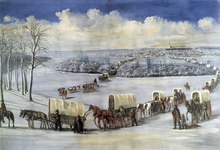today's post is on Covered wagons, the information came from Wikipedia Yes I am copying stuff from there however it does take a lot of time doing the research of old ancient auto/transportation
The covered wagon, also called the prairie schooner, was a vehicle usually made out of wood and canvas that was used for transportation,[2] prominently in pre-industrial America. With roots in the heavy Conestoga wagon developed for the rough, undeveloped roads and paths of the colonial East, the covered wagon spread west with American migration. The Conestoga wagon was far too heavy for westward expansion. Typical farm wagons were merely covered for westward expansion and heavily relied upon along such travel routes as the Great Wagon Road, the Mormon Trail and the Santa Fe and Oregon Trails, covered wagons carried settlers seeking land, gold, and new futures ever further west.
Throughout the 20th century, the covered wagon grew to become an icon of the American West.
History[edit]
Once breached, the moderate terrain and fertile land between the Appalachians and the Mississippi was rapidly settled. In the mid-nineteenth century thousands of Americans took a wide variety of farm wagons[3] across the Great Plains from developed parts of the Midwest to places in the West such as California, Oregon, Utah, Colorado, and Montana. Overland migrants typically fitted any sturdy wagon with five or six wooden or metal bows that arched high over the bed. Over this was stretched canvas or similar sturdy cloth, creating the distinctive covered wagon silhouette.
Prairie schooner is a fanciful name for the covered wagon, drawing on their broad white canvas covers, romantically envisioned as the sails of a ship crossing the sea.[4]
For "overlanders" migrating westward, covered wagons were a more common mode of transportation than wheelbarrow, stagecoach, or train. Oxen were the most common draft animal for pulling covered wagons, although mules and horses were also used. Authors of guidebooks written for emigrants noted that oxen were more reliable, less expensive, and nearly as fast as other options.[5]







Can you imagine crossing the country in such a wagon, with the fear of hostile people, wild animals, and sickness too. So much to consider. Our pioneers were certainly brave and bold. Thank you for sharing this. Very interesting information!
ReplyDeleteHonestly I don't think I would like it. However, with the way inflation has been rising, we may all be going back that way
ReplyDelete